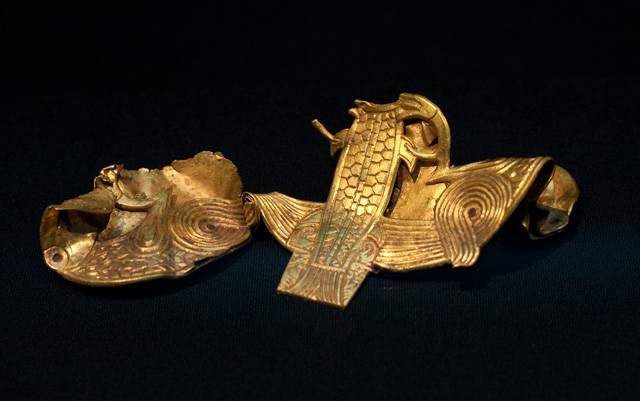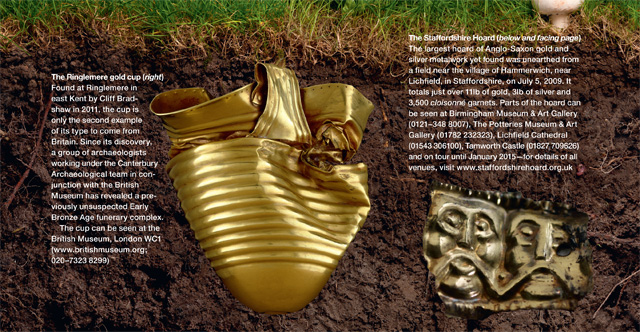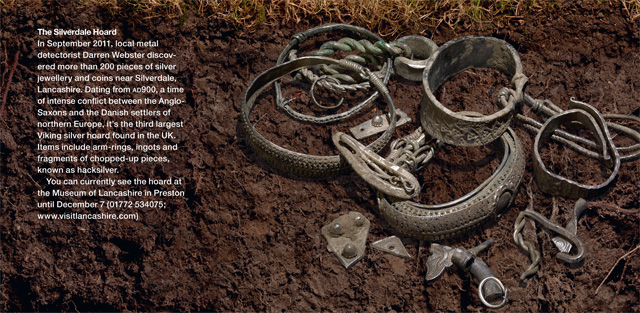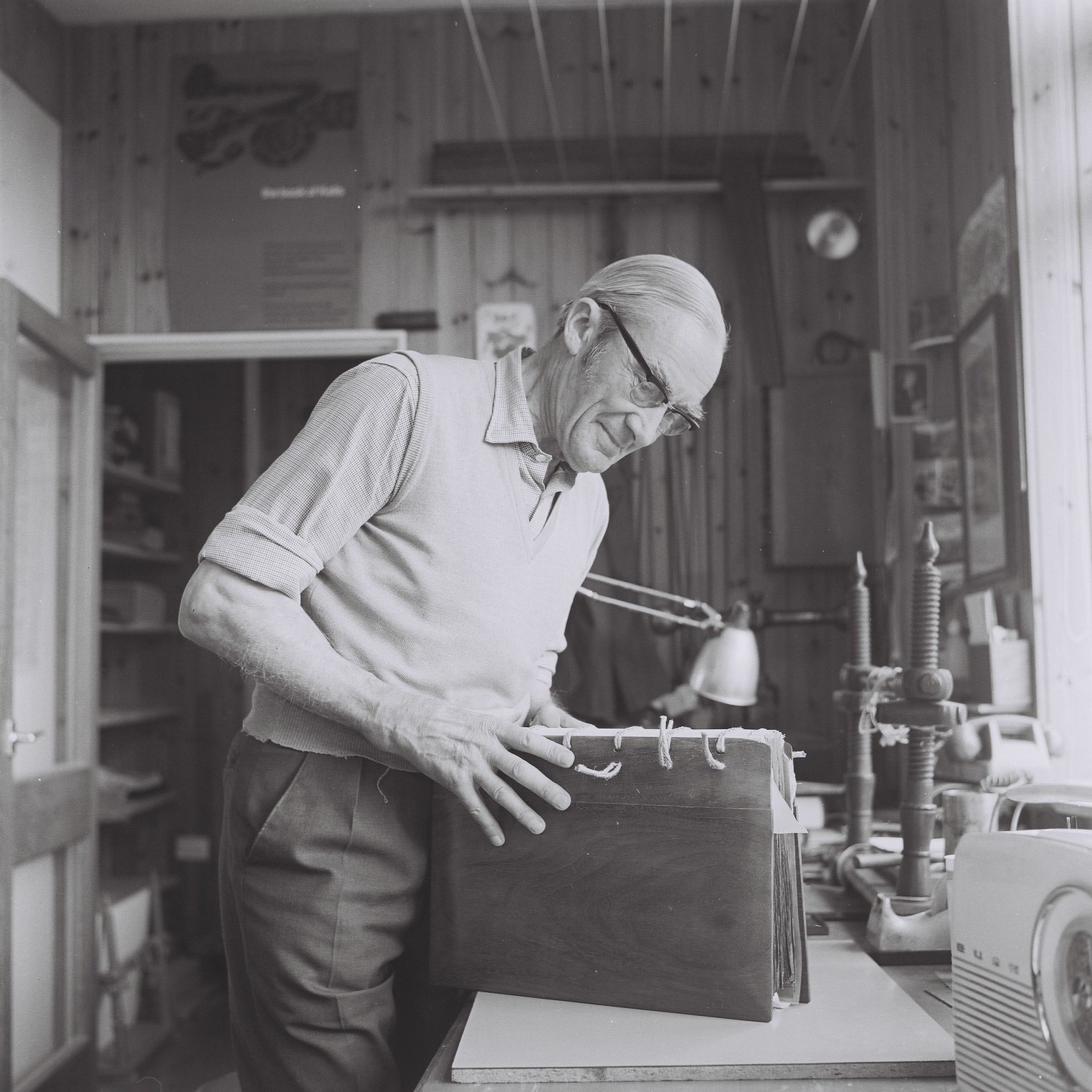Here be treasure
There is still treasure to be found beneath our fields and moorland, says Clive Aslet, and metal detectorists have an important part to play


Pinned on the wall above Michael Lewis’s desk is a photograph of a crumpled metal object, which, to the untutored eye, might be mistaken for a crushed baked-bean tin.
But, as we’re in the British Museum and he’s responsible for the Portable Antiquities Scheme, it doesn’t take long to realise that this is an object of great archaeological significance: no less a piece than the Ringlemere Cup, one of only two such gold cups ever to have been found in this country. It dates from about 1700bc–1500bc. Mr Lewis first saw it in 2001.
It was inside an old ice-cream tub where Cliff Bradshaw had put it for safekeeping after he’d found it using his metal detector. Yes, a metal detector. To some landowners and scholars of the old school, metal detectorists may still appear to be a cloven-hoofed breed, whose activities destroy archaeological sites rather than add to our knowledge of them.
They will be surprised to hear that Mr Lewis, an archaeologist, actually welcomes their activities. ‘Most archaeology these days takes the form of rescue digs, going in before new developments. Little takes place in rural areas. We’re interested in what the objects found by metal detectorists tell us about the past.’

The Ringlemere Cup is a case in point. When archaeologists studied aerial photographs of the area around which it was found, they noticed that the ground was studded with round marks, indicating barrows. A dig was organised by the British Museum, with the help of the Canterbury Archaeological Trust, which led to the discovery of a Bronze Age ditch and eventually a large Anglo-Saxon cemetery. Nobody would have thought of looking there if it hadn’t been for Mr Bradshaw and his metal detector.
Oh, and the value of the cup as Treasure Trove was put at £270,000. Such finds are the stuff of metal detectorists’ dreams. However, to say that they are the exception, rather than the rule, is to put it mildly. In Norfolk, Garry Crace has been metal detecting for 40 years, during which he has made seven or eight Treasure finds. Treasure in England, Wales and Northern Ireland is tightly defined under the 1996 Treasure Act to comprise various types of hoard, coins of more than 300 years old with a gold or silver content of at least 10%, and more recent gold and silver objects that were deliberately buried, with the intention of being recovered later. When found, it has to be reported to the coroner within a fortnight. It will then be offered to a museum at a price set by an independent board of experts. Not all Treasure, however, is spectacular. The largest of the pieces found by Mr Crace is a medieval silver-gilt finger link. ‘They may be no bigger than a fingertip,’ he observes. Finds that are not Treasure come under the Portable Antiquities Scheme, which employs 38 archaeologists around the country to assess their importance and record where they were discovered.
Metal detecting has a long history. One of the first machines was invented by Alexander Graham Bell, father of the telephone, and used in a desperate attempt to locate the bullet lodged in the body of the American President James Garfield by an assassin. Bell’s device failed—it reacted to the metal bed springs as well as the bullet— and Garfield died. After the Second World War, metal detectors could be made small enough for an individual to carry, thanks to transistors. Each one being used in Britain required a Pipe Finders licence.
Sign up for the Country Life Newsletter
Exquisite houses, the beauty of Nature, and how to get the most from your life, straight to your inbox.
At the end of the 1970s, numbers soared from under 20,000 to nearly 140,000. Then, the 1980 Wireless and Telegraphy Act scrapped the need for a licence. Numbers could no longer be monitored. There followed what Mr Crace remembers as a decade of ‘animosity’ between detectorists and archaeologists, ‘because there was no archaeological body with which detectorists could engage’. The Portable Antiquities Scheme provided a means by which finds could be logged. Although voluntary, it works well. Last year, as many as 80,000 finds were recorded. Accurately noting locations has become easier since the advent of GPS. Mr Crace is an example of a detectorist who takes his hobby seriously.
‘I write what amounts to a dig report on each project. I map finds by historical period. Everything is put on paper.’ His finds are generally offered to museums, unless the landowner wishes to keep them. Mr Crace believes that most detectorists want cordial relations with the owners of the land over which they are working; by law, they have to obtain the landowner’s consent. However, he accepts that the community is broad and not everybody is motivated by a love of the past. Vultures can be seen combing seaside beaches, hoping to find rings or coins that holidaymakers have lost. Their activities, however distasteful, are perfectly legal—not so those of the nighthawks who appear after dark, to search fields surreptitiously.
In Suffolk, John Browning has been plagued by the latter for 40 years. ‘Very few people have ever asked me for permission,’ he avers. ‘Many individuals don’t realise that the countryside is made up of private property.’
One of his two farms contains a 55-acre Scheduled Monument, on which footprints and little holes invariably used to appear after ploughing. To use a metal detector over a Scheduled Monument without the permission of English Heritage or Cadw is itself illegal and police have often made arrests; after one fracas on Mr Browning’s driveway in the 1980s, three people were given custodial sentences.
Latterly, the problem has eased, but only because of a change in farming regime. The land in question is now under grass and grazed by sheep; pasture is harder for the nighthawks to dig up. But he believes that his neighbours still suffer their attentions. English Heritage takes illegal activity at old buildings and archaeological sites so seriously that it has established the Alliance to Reduce Crime Against Heritage (ARCH).

Last summer, a nighthawk was convicted of going equipped to steal and theft of eight of the items found at his home—four coins, two brooches, a mount and an enamel bead, valued at a total of £500. He was given a conditional discharge for 12 months, the stolen artefacts were forfeited, his metal-detecting equipment was confiscated and he was ordered to pay £400 in court costs. Mark Harrison, National Policing and Crime Advisor for English Heritage’s Heritage Crime Programme says: ‘Illicit metal detecting has been prosecuted before, but this is the first time we’ve taken such a co-ordinated approach, involving an expert lawyer, dedicated police investigators, finds experts and archaeologists. It sets a valuable template for future cases elsewhere in the country.’ Fortunately, the number of rogues appears to be far outweighed by the number of detectorists who want to pursue a hobby in the open air.
Both the National Council for Metal Detecting (www.ncmd.co.uk) and the Federation of Independent Detectorists (www.fidnewbury.net) have codes of conduct. For landowners and tenant farmers, the Portable Antiquities Scheme is in the process of revising the guidance that it has drawn up in collaboration with the CLA and the NFU, observing, for example, the dangers to archaeology posed by metal-detecting rallies. Helen Shipsey, senior legal advisor of the CLA, emphasises the desirability of a written agreement being in place in advance of any metaldetecting activity. The CLA has one it can provide for a small fee.
In general, metal detecting deserves to be viewed with a kinder eye than it was three decades ago. But harmonious relations are themselves a kind of treasure; a little foresight will help preserve them.
Code of conduct * Draw up a ‘finds agreement’ in writing with anyone wishing to search your land * Ask to see all archaeological finds discovered * Ask that all finds are recorded with the local Finds Liaison Officer —each find will have a unique reference number that can then be searched online * Consider donating important finds to a local museum or give it first refusal on objects offered for sale * Report any illegal activity to the police
Enforcing the law
In 2010, Chief Inspector Mark Harrison was seconded from Kent Police to be the policing advisor to English Heritage. It was the ideal job: one of his childhood ambitions had been to be an archaeologist. A number of cases have been successfully prosecuted and are logged on the Heritage Crime page (www.englishheritage.org.uk).
‘We’ve formed a really good relationship with the National Council for Metal Detecting,’ says Inspector Harrison. ‘But we have evidence that some nighthawks will drive 200–300 miles in a night and use staggeringly sophisticated equipment to raid sites.’ A growing threat is posed by divers, who hope to plunder underwater sites.
However, co-ordinated policing and better intelligence have increased the effectiveness of the police. The new Police and Crime Commissioners have formed a National Rural Crime Network and Inspector Harrison has been helping to train forces other than Kent; Sussex Police now has more than 70 officers with heritage training.
The importance of a set code of conduct can’t be underestimated. ‘The Staffordshire Hoard was discovered in a potato field, the finder reported it to the authorities and a new window has been opened onto our understanding of the Dark Ages. If it had been dispersed across the planet, an opportunity for knowledge that is beyond price would have been lost,’ Inspector Harrison stresses.
* This article was first published in Country Life magazine on July 23 2014.
-
 What's a 'wellness village' and will it tempt you back into the office?
What's a 'wellness village' and will it tempt you back into the office?The team behind London's first mixed-use ‘wellness village’ says it has the magic formula for tempting workers back into offices.
By Annunciata Elwes
-
 'To exist in this world relies on the hands of others': Roger Powell and modern British bookbinding
'To exist in this world relies on the hands of others': Roger Powell and modern British bookbindingAn exhibition on the legendary bookbinder Roger Powell reveals not only his great skill, but serves to reconnect us with the joy, power and importance of real craftsmanship.
By Hussein Kesvani